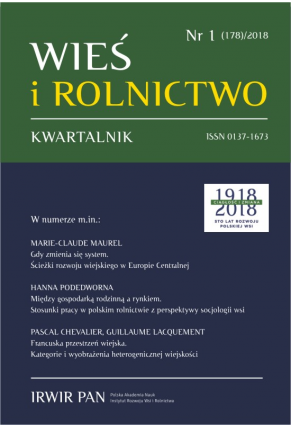Village Changes the System: Development Paths of the Village in Central Europe
DOI:
https://doi.org/10.53098/wir012018/03Keywords:
rurality, system change, post-collectivism, trajectory, path dependencyAbstract
The article presents an economic and social assessment of the post-collectivist period in Central Europe based on the research work conducted in closed cooperation by Maria Halamska and Marie-Claude Maurel. After defining the methodological and epistemological conditions underlying fieldwork, the study retraces temporal stages of the system change, from the time of decolectivisation to the reshaping of rural areas, underlining the diversity of the rural trajectories.
References
Chevalier P., Maurel M.-C. (2010). LEADER w krajach Europy Środkowej. Mechanizmy transferu modelu rozwoju lokalnego. Wieś i Rolnictwo, 4 (149), 26–41. DOI: https://doi.org/10.53098/wir.2010.4.149/02
Chevalier P., Maurel M.-C. (2013). The LEADER programme in Central Europe: A new local development policies. Acta Universitatis Lodziensis, Folia Sociologica, 44, 39–52.
Gorzelak G. (1998). Regional and Local Potential for Transformation in Poland. Warszawa: EUROREG.
Halamska M. (1995). La difficile reconversion de l’agriculture étatique en Pologne. Revue d’Etudes comparatives Est-Ouest, 26, 91–118. DOI: https://doi.org/10.3406/receo.1995.2741
Halamska M. (1997). Decollectivisation of agriculture in Central Europe: the first regularities of the process. Eastern European Countryside, 3, 7–19.
Halamska M. (1998). Dekolektywizacja rolnictwa w Europie Środkowej i jej społeczne konsekwencje. Warszawa: Instytut Rozwoju Wsi i Rolnictwa PAN.
Halamska M. (2001). Reprodukcja czy wymiana? Przekształcenia lokalnych elit politycznych w Polsce w latach 1990–1998. Warszawa: Wydawnictwo Naukowe Scholar.
Halamska M. (2008). L’avenir des petites exploitations agricoles et de leurs propriétaires. W: M. Halamska (red.). L’agriculture française et l’agriculture polonaise dans l’Europe de 2007: expériences partagées et intérets communs? (s. 38–56). Varsovie–Paris: Centre de l’Académie Polonaise des Sciences.
Halamska M. (2009). Social capital of rural areas: Attempt at reconstruction. Przegląd Socjo logiczny, 4 (57), 69–94.
Halamska M. (2016a). Processes of change in the social structure of Poland’s rural population in the years 1991–2013. Wieś i Rolnictwo, 4 (173), 81–99. DOI: https://doi.org/10.53098/wir042016/05
Halamska M. (2016b). Struktura społeczno-zawodowa ludności wiejskiej w Polsce i jej przestrzenne zróżnicowanie. Wieś i Rolnictwo, 1 (170), 59–85. DOI: https://doi.org/10.53098/wir012016/04
Halamska M., Lamarche H., Maurel M.-C. (2003). Rolnictwo rodzinne w transformacji postkomunistycznej. Anatomia zmian. Warszawa: Instytut Rozwoju Wsi i Rolnictwa PAN.
Halamska M., Maurel M.-C. (1993). Proces przekształceń lokalnych elit politycznych w Polsce. Wieś i Rolnictwo, 1, 67–93.
Halamska M., Maurel M.-C. (1997). The Farmers of Europe: Differences of views, attitudes, identities. Polish Sociological Review, 1, 59–74.
Halamska M., Maurel M.-C. (2010a). Decollectivisation of agriculture and reshaping of agrarian structure in Central Europe. Przegląd Socjologiczny, 59 (2), 29–56.
Halamska M., Maurel M.-C. (2010b). Les acteurs locaux à l’épreuve du modèle européen. France, Hongrie, Pologne. Praga: CEFRES, Instytut Rozwoju Wsi i Rolnictwa PAN.
Halamska M., Michalska S., Śpiewak R. (2010). LEADER w Polsce. Drogi implementacji programu. Wieś i Rolnictwo, 4 (149), 104–119. DOI: https://doi.org/10.53098/wir.2010.4.149/07
Illner M. (1995). Les conséquences sur le plan territorial du changement politique et économique en République tchèque. Cahiers du CEFRES, 9, 19–36.
Lacquement G., Maurel M.-C., Raynal J.-C. (2011). Trajectoires d’une ruralité recomposée en Europe centrale. Economie rurale, 325–326, 39–53. DOI: https://doi.org/10.4000/economierurale.3234
Lamarche H., Maurel M.-C. (1995). Transitions agraires en Europe centrale. Etudes rurales, Année, 138–140. DOI: https://doi.org/10.3406/rural.1995.3530
Maurel M.-C. (1994). La transition post-collectiviste. Mutations agraires en Europe centrale. Paris: L’Harmattan.
Maurel M.-C. (1997). Stratégies d’appropriation de la terre et du capital dans les agricultures centre-européennes. W: A. Olivier (red.). Původní a noví vlastníci (Anciens et nouveaux propriétaires) (s. 14–24). („Cahiers du CEFRES” nr 11). Praga.
Maurel M.-C. (2004). Les enjeux des mutations des territoires ruraux. L’improbable convergence vers un modèle agricole européen. W: B. Chavance. De la transformation post-socialiste à l’intégration européenne (s. 147–180). Paris: L’Harmattan.
Maurel M.-C. (2005). Temps de recomposition des territoires ruraux en Europe centrale. Retour sur une expérience de terrain. Revue d’études comparatives Est-Ouest, 36 (2), 5–38. DOI: https://doi.org/10.3406/receo.2005.1706
Maurel M.-C. (2012). La grande maille agraire en Europe centrale: un invariant spatio-temporel? Etudes rurales, 190, s. 25–48. DOI: https://doi.org/10.4000/etudesrurales.9664
Maurel M.-C. (2015). From disappearance to recovery: Family farming in Central Europe. Questioning the path dependency hypothesis. Wieś i Rolnictwo, 1, 79–106. DOI: https://doi.org/10.53098/wir.2015.1.1.166.1/05
Maurel, M.-C. (red.) (1994). Les décollectivisations en Europe centrale. T. 2. Itinéraires de privatisation. „Espace Rural”, nr 33, Montpellier.
Maurel M.-C., Chevalier P., Lacquement G. (2014). Transfert et apprentissage du modèle LEADER en Europe centrale. Paris: L’Harmattan.
Maurel M.-C., Halamska M. (2006). Démocratie et gouvernement local dans la Pologne rurale. Paris: CNRS éditions.
Maurel M.-C., Halamska M., Lamarche H. (2003). Le repli paysan. Trajectoires de l’aprèscommunisme en Pologne. Paris: L’Harmattan.
Maurel M.-C., Lacquement G. (2007). Agriculture et ruralité en Europe centrale. Paris: Aux lieux d’être-CEFRES.
Maurel M.-C., Pola P. (2010). L’émergence du développement local le cas de Bóly en Transdanubie méridionale. W: M. Halamska, M.-C. Maurel. Les acteurs locaux à l,épreuve du modèle européen LEADER: France, Hongrie, Pologne (s. 149–184). Prague: CEFRES–Instytut Rozwoju Wsi i Rolnictwa PAN.
Downloads
Article file downloads
Pages
How to Cite
Issue
Section
License
Copyright (c) 2018 Village and Agriculture

This work is licensed under a Creative Commons Attribution 4.0 International License.










